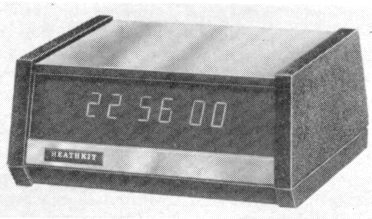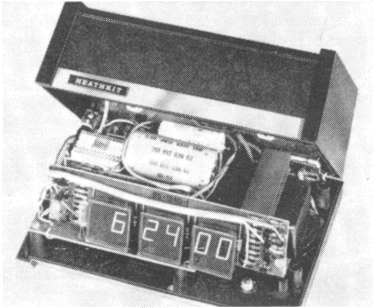 According to the hands on our old wall clock, it was a "quarter to nine"
when we arrived at the office to begin the workday. That is the way
most of us "read" time - after interpreting what is meant by
the various positions of the hands on the dial face, we put the
number of minutes to or after the hour first and follow with the hour,
forgetting the seconds altogether. But with the new breed of
numeric-readout digital electronic clocks on the market, one is
forced to tell time in the proper manner. So, a glance at our Heathkit
Model GC-1005 digital clock told us that our actual arrival time was
a more precise 8:45:36 a.m.
According to the hands on our old wall clock, it was a "quarter to nine"
when we arrived at the office to begin the workday. That is the way
most of us "read" time - after interpreting what is meant by
the various positions of the hands on the dial face, we put the
number of minutes to or after the hour first and follow with the hour,
forgetting the seconds altogether. But with the new breed of
numeric-readout digital electronic clocks on the market, one is
forced to tell time in the proper manner. So, a glance at our Heathkit
Model GC-1005 digital clock told us that our actual arrival time was
a more precise 8:45:36 a.m.
Telling time by the digital method is actually no more difficult than it was to tell time "by the hands." Once one gets over the initial awkwardness of having the time displayed by hours, minutes, and seconds in that order, telling the time is easy. It is faster too, because you do not have to interpret what the numbers mean.
Heath's GC-1005 digital clock can be used in any room of a home or office. For those areas where reading time at a distance is the norm, the readouts provided are gas-discharge 7-segment Sperry Rand SP-352 units whose extra-large numerals are clearly legible at distances of 25 ft or more. A unique alarm feature makes the clock ideal for bedroom use.
When assembled, the clock is fully enclosed inside a plastic case with a simulated walnut top and black end panels. The front panel contains a full-width readout filter behind which are an a.m./p.m. indicator and six numeric readouts arranged in pairs for hours, minutes, and seconds.
The case measures 7" × 5" × 2-1/2" in overall dimensions and switghs a mere 3 lb. The retail price of the kit from the factory in Benton Harbor, Michigan, is only $54.95, making it perhaps the least expensive sophisticated digital electronic clock around.
Technical Details. All of the digital logic functions of the clock are performed inside one of the most complex and sophisticated MOS/LSI clock chips currently available. This single 24-pin IC can be externally pre-programmed to provide either a 12- or a 24-hour time format and to permit the clock to utilize either a 50- or 60-Hz line power frequencies, depending upon whether or not certain jumpers are installed on a PC board. Aside from the usual counting and decoding functions performed by all clocks, the LSI chip also has a built-in strobe, or multiplexing, circuit for the display and a programmable alarm circuit.
The alarm circuit is designed to operate on a 24-hour duty cycle (two 12-hour cycles in the event that the board is wired for a 12-hour time format), sounding only once in a given 24-hour period. Unique to this alarm circuit is a "slumber" feature that permits the user to operate a spring-loaded slide switch to disable the alarm's gentle "beep" for 7 minutes, after which the alarm again sounds. The slumber switch can be operated as often as desired for up to one hour after the alarm initially sounds.
The use of a single LSI chip to perform all of the digital logic functions in the clock minimizes the number of discrete components needed to 21 transistors, 12 diodes, a handful of coupling and filtering capacitors, and about six dozen biasing and dropping resistors. Seven of the transistors are used to strobe the segments of all readouts simultaneously. Twelve others strobe the readout stages and provide high-voltage isolation for the LSI chip. Another transistor is used to drive the alarm speaker, and a final one is used in the alarm-set circuit.
Six slide switches are provided for controlling all alarm and time setting functions. On the rear panel are the ALARM ON/OFF and SNOOZE ALARM switches where they are easy to get at. The less used TIME-HOLD, ALARM-SET, MINUTES SET-AHEAD, and HOURS SET_AHEAD switches are all located on the bottom of the cabinet.
 General Comments. Our Heathkit Model GC-1005 digital electronic
clock arrived in kit form. Having in the past assembled clock kits
built around a multitude of IC's and circuit boards, we anticipated
a long, tedious time of kit building. However, we were pleasantly
surprised to find that this was one of the easier kits in our experience.
After flipping through the assembly/operating manual supplied with the
kit and noting how few parts were to be mounted onto just two
printed circuit boards (one for the readout assembly, the other for the
logic and power supply), we were eager to get started. So, in about
4-1/2 hours, we had our clock ready for the acid test. Assembling the
kit posed no particular problems except that the MOS/LSI chip required
special handling to avoid damaging it through static electricity.
General Comments. Our Heathkit Model GC-1005 digital electronic
clock arrived in kit form. Having in the past assembled clock kits
built around a multitude of IC's and circuit boards, we anticipated
a long, tedious time of kit building. However, we were pleasantly
surprised to find that this was one of the easier kits in our experience.
After flipping through the assembly/operating manual supplied with the
kit and noting how few parts were to be mounted onto just two
printed circuit boards (one for the readout assembly, the other for the
logic and power supply), we were eager to get started. So, in about
4-1/2 hours, we had our clock ready for the acid test. Assembling the
kit posed no particular problems except that the MOS/LSI chip required
special handling to avoid damaging it through static electricity.
When we first plugged the clock's line cord into the a-c outlet, the display indicated all 8's, the normal condition for a properly operating clock of this type. (All 8's also show up when power has been interrupted to the clock for more than a few seconds to tell the user to reset the time.) Once we knew that the clock had no problems, we quickly set it to the proper time with the aid of the TIME-HOLD, MINUTES SET-AHEAD, and HOURS SET-AHEAD switches. We also set the alarm with the aid of the ALARM-SET switch. Everything worked without a hitch.